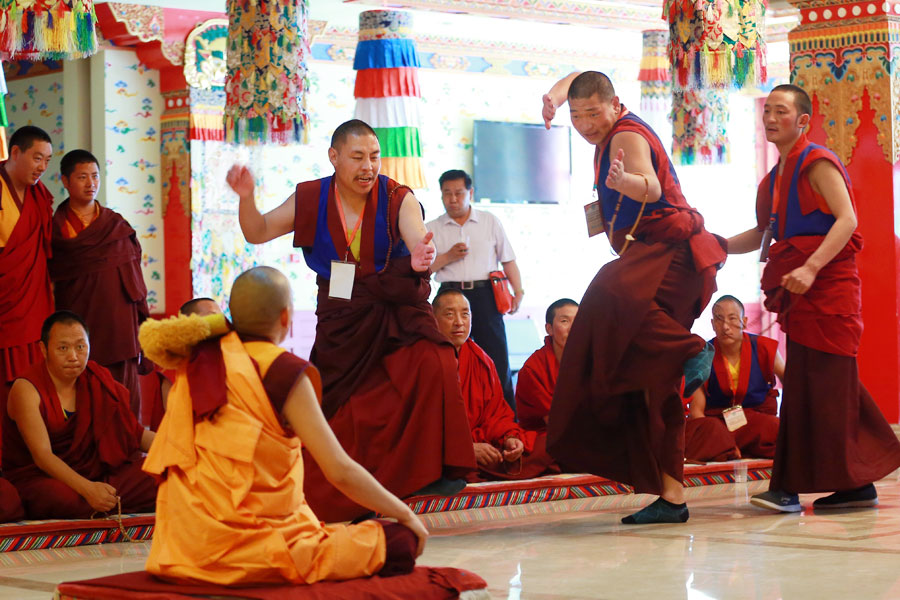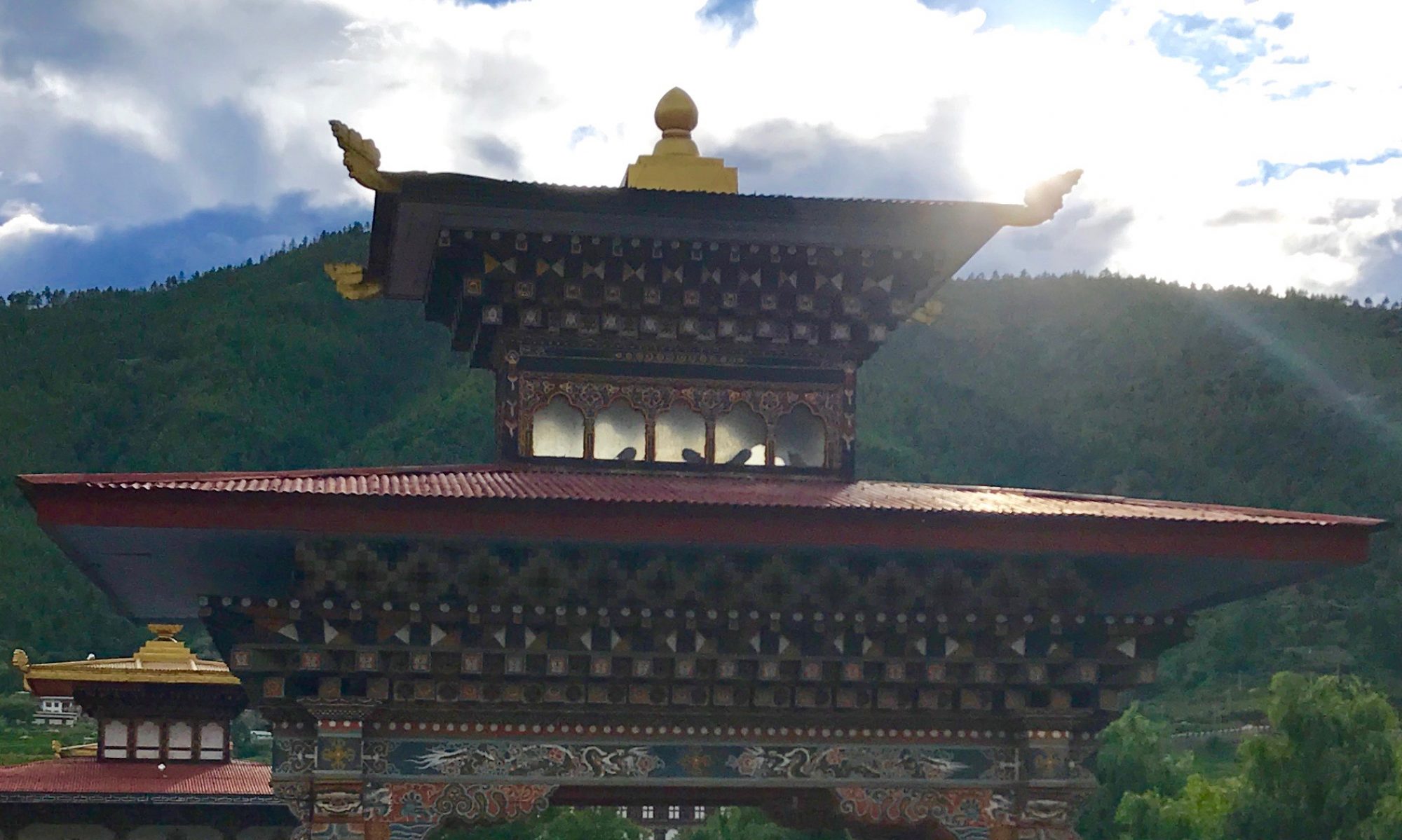Nobody warned us that today would be different from the rest of the retreat, so we headed over around 4:30 p.m., only to find the temple packed with people. As we arrived, there were dozens of people leaving, and others circumambulating the temple but not going inside. What I think of as the back door (to the east, where the older people tend to sit), was closed off with a metal grate, so the only entrance was through the front. We teetered, on the brink of going away, but one of the monks we now think of as a friend—the one who nudges sleeping monks awake—said, “Come in!” and walked in through the lines of people. Jeremy and I stopped and prostrated in the middle of the aisle—which seems to have been not the right thing on this particular day (but no one told us, so how were we to know?). Then, as I looked around a little wildly for somewhere to sit, our friend came back and said, “You can sit on the other side. Come with me.” He led us back behind the altar (I put my head against the foot of the statue of Guru Rinpoche, just as Sonam Seldin taught me to do) and we squeezed in in front of Tshering Thinley’s mother and some of the other older women regulars.
We arrived in the middle of what seemed like a sermon: one of the less senior monks was standing at a podium, wearing a red pointed hat, speaking at some length. After he finished, our friend the monk of the gate stood at the podium without a hat and spoke. He made people laugh—even the abbot (the khenpo)! It was lovely to see Khenpo’s face lit up with pleasure: he has a lovely smile and a lovelier laugh.
Then there was a debate: one monk seated, wearing the red hat—a second monk standing, pacing, setting questions and punctuating those questions by pulling his prayer beads up his arm, stomping and slapping one hand against the other. At times, when the seated monk was speaking, I could see Khenpo’s lips moving in time with the words. The standing monk went up to the seated monk at one point and swept his robes across the other man’s face. A few moments later, he stripped off his outer robe and tied it around his waist, still pacing, pulling up the prayer beads, stomping and clapping. Jeremy was wide-eyed: the drama of it all was very engaging.

Once that debate was done, there was more speechifying—first more fluid speech, from our friend the monk at the gate, evoking more laughter, then another more solemn speech from one of the younger monks (not young, just not senior). As he spoke, I could again see Khenpo occasionally mouthing the words, as if cheering on his charge.
During this same time, one of the more senior monks was sprinkling and laying down scent from what seemed like a (recycled plastic) bottle of infused oil. The scent was strong and familiar, but I couldn’t quite put a name on it. When I asked Jeremy, he said promptly, “It’s the smell of the Lalit hotel” (the hotel we stayed at in Delhi)—an apt answer, even if it didn’t get me much further. Also at this time, younger monks were serving tea and snacks. The serving went on and on. The poor monks kept having to step around me and Jeremy. When some people got up and left, we were encouraged to move over to the places they had occupied, in front of some VIPs sitting on benches. Some of the people telling us to move over also made a Sherubtse student come and sit next to us in order to translate for us.
The next speech from our friend the monk at the gate was an introduction to a monk recounting the life of the Buddha. The introduction ran something like this: “The major world religions all have beautiful texts, which everyone knows about. Muslims have Mohammed, the Messenger of their God; Christians have Jesus Christ, whom everyone knows; Hindus have their pantheon of gods—but if you ask a Bhutanese person, ‘Who is Buddha?’ all they will say is, ‘He is a man with a knot on his head.’” [Laughter.] The more solemn speech recounted Buddha’s achievements from birth to nirvana (not just enlightenment, but his achievements as a teacher, post-enlightenment).
The next introduction (according to my translator) contrasted the followers of Buddha in his own time with those who become Buddhists in the present day. “In Buddha’s time, those who followed him were among the wealthiest and most accomplished people in India. Today, the opposite is true: those who become monks are among the most financially challenged people in Bhutan. People who have been drug addicts and want to change their ways turn to Buddhism—or the parents of a drug addict enroll him as a monk.” (“And they laughed at these words!” said my translator.) “Buddha never tried to persuade anyone to become a Buddhist—rather, he showed a path and people could choose to follow it or not.” The subsequent speech was supposed to deal with Buddhist practices. My translator said he would let me know whether there was anything relevant to me, but nothing seems to have struck him as relevant. Instead, he started up a side conversation as to whether or not I found it offensive to be called “madam.” (I suspect he’s been treated to Leyla’s views on the word “madam.”)
Meanwhile, treats kept being offered: a puffed rice treat, soaked in oil and combined with coarse sugar grains. It was hard to chew: everything here seems to be hard to chew. They gave us far too much and then it was hard to know what to do with it. In the end, I spilled it all over the inside of my bag and even into the handle of the umbrella. Ugh. And then the monks came around with doma! Leaf, betel nut, lime paste. Men and women—but not all men or all women—both accepted some.
Then came another debate: this time with three monks seated and another three interrogating them. “It can get heated,” my translator said happily. “But it’s all in Chöki (Tibetan scriptural language) so even we can’t understand what they’re saying.” The three standing monks jockey for position. Two speak at a time and move to the front. The Sherubtse graduate stands a little farther back, looking as if he is trying to find a way into fuller participation. Then the pattern shifts, and he is the leader, moving forward, speaking strongly, clapping. Suddenly two other monks plunge in the melee: “Any of the monks on the floor, if they hear a point where they have something to contribute, they can join in,” explains my translator. The two new monks—one of them especially—raise the heat of the debate considerably. They plunge toward the seated monks, they raise their voices, they stomp on the answers with more and more sharp retorts and claps. Occasionally one of the original three will pull them back from the seated monks by their robes. Occasionally one of the new monks thrusts forward through the others once again. Spectators (VIPs) are standing, moving closer, bringing out their cell phones to take a video of the debate. When they sit down again, I see Khenpo gesturing the standing monks to step back. Most of them move back promptly, but the most energetic interrogator can’t stop. He keeps dancing forward, slapping, making his point, circling back three or four times while our friend the monk at the gate says thank you [gedinche la] three times. Finally the challenging monk is done. All of the debaters exit the center area, and our friend the monk at the gate is speaking again, this time noting that one must debate with the right attitude. The goal is to help the monks being questioned to clarify their own path. If one is only trying to score points against an opponent, that is not the right attitude. This seemed meant as a commentary on the debate we just witnessed.
One of the things I liked best about the evening was seeing the whole community gathered: across the room from us, the president of Sherubtse College sat next to two policemen. Behind us were other solid citizens (though I’m too ignorant of local politics to know who they were). They shared their tea with us, and had Jeremy come and sit on a bench with them when he was particularly restive. Also, after Jeremy peeked around the curtain into the corner room, the monks invited him to come and sit in there with him (but he was too shy to go).
At Jeremy’s insistence, I asked my translator how much longer the evening would last, and the answer was “Quite a while.” My sense is that this service was not unlike a Christian lessons and carols service: you teach as much of the tradition as possible to an audience you may be able to tap only once a year. Jeremy and I fidgeted for a while longer, and then the student said, “I am going to leave: do you want to follow me?” So we did—only to find our shoes full of rain. The president’s Personal Assistant PA was outside, asking Jeremy whether there would be school the next day. We asked him whether college classes would be canceled (as the student had projected). “No,” Tshering snorted. Of course not. I asked what would be happening on Wednesday, and he said that if we were interested, we could line up along the path of the monks and put some candy in their begging bowls. So off we went to get candy at Sonam’s and then we went home for a late supper and bed.
